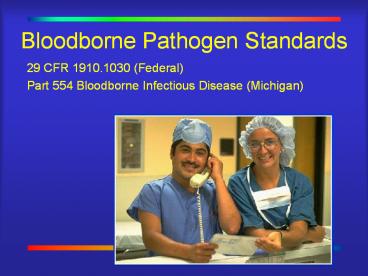Bloodborne Pathogen Standards - PowerPoint PPT Presentation
1 / 27
Title:
Bloodborne Pathogen Standards
Description:
Title: PowerPoint Presentation Author: Brad McCormick Last modified by: rmanninen Created Date: 12/20/2001 10:24:08 PM Document presentation format – PowerPoint PPT presentation
Number of Views:257
Avg rating:3.0/5.0
Title: Bloodborne Pathogen Standards
1
Bloodborne Pathogen Standards
- 29 CFR 1910.1030 (Federal)
- Part 554 Bloodborne Infectious Disease (Michigan)
2
What are BBP Standards?
- To protect workers against possible contamination
from a Bloodborne Infectious Disease
3
When to comply?
- If there is a reasonable anticipated risk of
exposure to blood or OPIM during routine tasks
4
Definitions
- Bloodborne pathogens - pathogenic microorganisms
transmitted via human blood and cause disease in
humans - HIV - virus that causes AIDS (incubation 1-10
years) - Hepatitis B (HBV) - acute or chronic infection of
liver (incubation 2-3 months) - Hepatitis C (HCV) also infects liver
(incubation 6-9 weeks)
5
Other Potentially Infectious Material (OPIM)
(State Rule 325.7002(s))
- Semen
- Vaginal secretions
- Amniotic fluid
- Cerebrospinal fluid
- Peritoneal fluid
- Pleural fluid
- Pericardial fluid
- Synovial fluid
- Saliva in dental procedures
- Any bodily fluid that is visibly contaminated
with blood
6
Sharps
- Any item that has a potential to cut or puncture
skin. (broken glass, needles, lancets, etc.)
7
Universal Precautions
- ALL blood and OPIM treated as infectious
8
Standard Operating Procedures (SOPs)
- Each task should have a written procedure to
reduce risk of exposure
9
Engineering Controls
- Products that reduce exposure by design
- Examples self sheathing needles, sharp
containers, sinks
10
SESIPSharps with Engineered Sharps Injury
Protections
- Non-needle sharp or a needle with a built-in
safety feature or mechanism that effectively
reduces the risk of an exposure incident.
11
Hypodermic syringes with Self-Sheathing safety
feature
Self-sheathed protected position
12
Hypodermic syringes with Retractable
Technology safety feature
Retracted protected position
13
Phlebotomy needle with Self-Blunting safety
feature
Blunted protected position
14
Add-on safety feature
Attached to syringe needle
Attached to blood tube holder
15
Retracting lancets with safety features
Before During After
Before During After
In use After use
16
Disposable scalpels with safety features
Retracted position
Protracted position
Protracted position
17
Work Practice Controls
- Reduce exposure by work habits
- Examples wearing gloves, washing hands, using
sharp containers, no food, etc. while working
18
Personal Protective Equipment (PPE)
- Specialized clothing/equipment worn for
protection against hazards - Choose correct ones for task
- Gloves, Protective Eyewear, Face Shield, etc.
- DON DOFF
19
Regulated Waste
- Determination of Regulated Waste - Michigan Law
- Medical Waste Regulatory Act - Part 138
- Law determines where it is sent and how much it
cost (incineration, public sewage, radioactive,
how it is packaged, segregated, labeled, etc.) - Use of red biohazard containers
20
Laundry
- Employers responsibility to launder the reusable
required PPE
21
Vaccination
- Employer must provide Hep B vaccination to
employee - Cost - Employers Expense
22
Waiver
- Employee has the right to decline HBV vaccine
- Must sign a waiver
- Employee has right to request a HBV vaccine at
later date, at employers expense
23
Post Exposure
- Determination what was BBP exposure?
- Procedure report, go to ER, document incident,
test patient - Prophylaxis
- Confidentiality
24
Biohazard Labels and Warnings
- Labels
- Colors blaze orange/red
- Symbols 3 sided
25
Recordkeeping
- 1. A Sharps Injury Log is filled out in addition
to OSHA 300 log (confidentiality maintained) - 2. BBP training is also documented
26
Sharps Injury Log
- At a minimum, the log must contain, for each
incident - Type and brand of device involved
- Department or area of incident
- Description of incident
27
BBP Training
- It is the Law
- Also known as Exposure Control Plan
- Newly hired and Annual retraining
- Also, training on new devices and procedures































